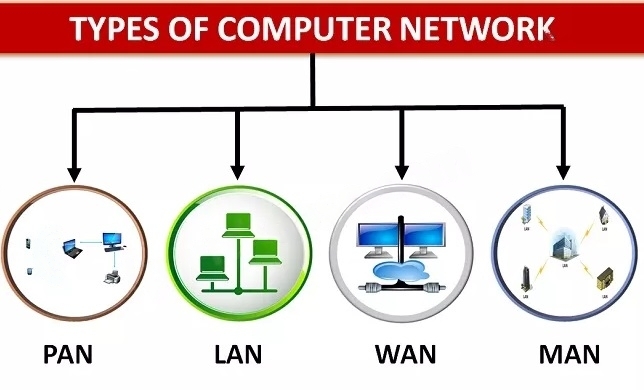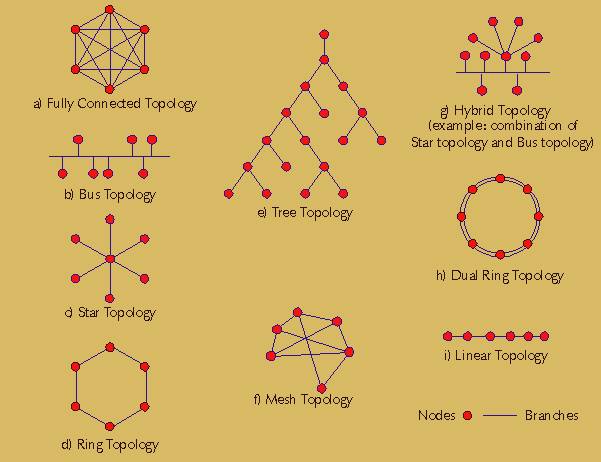Computer Networks - Topologies
A computer network is a group of computers that use a set of common communication protocols over digital interconnections for the purpose of sharing resources located on or provided by the network nodes.
Definition – A group of computers which are connected to each other and follow similar usage protocols for the purpose of sharing information and having communications provided by the networking nodes is called a Computer Network.
A network may be small where it may include just one system or maybe as large as what one may want. The nodes may further be classified into various types. These include:
- Personal Computers
- Servers
- Networking Hardware
- General Hosts
Networking can be classified into three types:
- Types of Computer Networks
- Topology
- Interpreters
Types of Computer Networks

There are five main types of Computer Networks:
- LAN (Local Area Network) –
- Systems connected in a small network like in a building or a small office
- It is inexpensive
- It uses Ethernet or Token-ring technology
- Two or more personal computers can be connected through wires or cables acting as nodes
- Transfer of data is fast and is highly score
- PAN (Personal Area Network) –
- The smallest computer network
- Devices may be connected through Bluetooth or other infra-red enables devices
- It has a connectivity range of upto 10 metres
- It covers an area of upto 30 feet
- Personal devices belonging to a single person can be connected to each other using PAN
- MAN (Metropolitan Area Network) –
- A network that can be connected within a city, for example, cable TV Connection
- It can be in the form of Ethernet, ATM, Token-ring and FDDI
- It has a higher range
- This type of network can be used to connect citizens with the various Organisations
- WAN (Wide Area Network) –
- A network which covers over a country or a larger range of people
- Telephonic lines are also connected through WAN
- Internet is the biggest WAN in the world
- Mostly used by Government Organisations to manage data and information
- VPN (Virtual Private Network): –
- A network which is constructed by using public wires to connect to a private network
- There are a number of systems which enable you to create networks using the Internet as a medium for transporting data
- These systems use encryptions and other security mechanisms to ensure only authorised users can access.
Network Topologies

Given below are the eight types of Network Topologies:
- Point to Point Topology – Point to Point topology is the simplest topology that connects two nodes directly together with a common link.
- Bus Topology – A bus topology is such that there is a single line to which all nodes are connected and the nodes connect only to the bus
- Mesh Topology – This type of topology contains at least two nodes with two or more paths between them
- Ring Topology – In this topology every node has exactly two branches connected to it. The ring is broken and cannot work if one of the nodes on the ring fails
- Star Topology – In this network topology, the peripheral nodes are connected to a central node, which rebroadcasts all the transmissions received from any peripheral node to all peripheral nodes on the network, including the originating node
- Tree Topology – In this type of topology nodes are connected in the form of a tree. The function of the central node in this topology may be distributed
- Line Topology – in this topology all the nodes are connected in a straight line
- Hybrid Topology – When two more types of topologies combine together, they form a Hybrid topology.
Network Devices
Discussed below are a few important network devices from the exam point of view:
- Network Repeater – Used to generate incoming electrical, wireless or optical signals
- Network Hub – It is a small network device. It joins multiple computers together to form a single network segment. On this segment, all computers can interact with each other
- Network Switch – It is a small hardware device which joins multiple computers together with a single LAN
- Network Router – This device interfaces in multiple networks whose task is to copy packages from one network to another. It provides connectivity inside enterprises, between Enterprises and the Internet and within an ISP
- Network Bridge – It reads the outermost section of the data packet to tell where the message is going. It reduces the traffic on other network segments.
- Modem – This device converts digital signals into analog signals. It is always placed between a telephone and a computer system